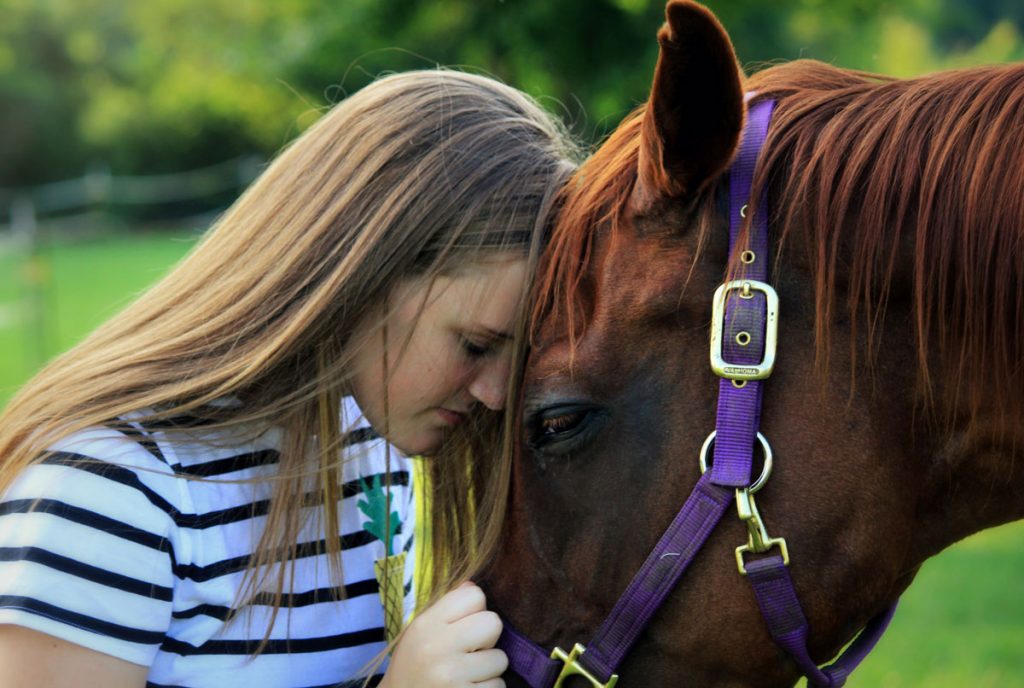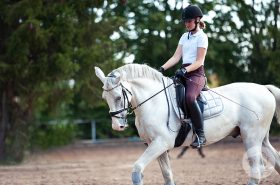I sometimes feel like my first horse, a Haflinger gelding, was my guinea pig.
In hindsight, I made so many mistakes with him. I wanted that amazing relationship I’d read about in books, something like Alex and the Black Stallion or National Velvet and The Pie. I believed in a truly special horse and human bond. Now that I’m a grown-up (sort of) I still believe that a special bond is possible. We all have unique challenges in life. Some of us have oodles of time and money while the rest of us are limited in both those areas. Nevertheless, we all want a great relationship with each and every one of our horses.
Here are the top 5-relationship mistakes we make with our horses.
Not being present.
We say that horses live in the moment and it’s very true. Humans, on the other hoof, do not. We live in a crazy fast-paced world of cell phones, startling news reports, and days that are jam-packed with to-do lists. Even when brushing my horse, my thoughts gravitate to events that happened earlier in my day or a task on my to-do list for tomorrow. I rarely live in the moment.
Our horses don’t understand any of this, but they do respond to our energy and mood.
I now make it a practice to stay present when I’m with my horse. I turn my phone off or put it on silent. Yes, I need to have a phone in case of emergency, but when I’m with my horse, I don’t take phone calls, I don’t text, and I save taking photos for the end of my session.
I read recently that horses can read our minds. I don’t believe they can read our minds, but I do believe they read our bodies. I no longer engage in conversations that are full of angst with fellow boarders. I noticed that as I told the story, my horse would look as anxious as I felt. It’s just a story, I’d think, a conversation, but I did a little research on why my story causes tension.
As it turns out, our limbic system, the part of our brain that is responsible for emotion, cannot differentiate between Then and Now. So, as we tell stories, our emotions (good or bad) are triggered by the limbic system, sending signals to our bodies and to our horses that something is wrong.
We know we’re just telling a story, but our horses do not and that can make our horses feel as bad as we do.
We forget to breathe.
Breath is the most important tool we have in working with horses and many of us have forgotten how to breathe for good health and relaxation. Diaphragmatic breathing or belly breathing is a great practice to relax yourself and your horse. The diaphragm is one of the largest muscles in the body. It’s shaped like a mushroom and is located between the thorax and the abdomen. It’s job is to expand the thoracic cavity for better lung capacity. To experiment, lie on your back on the floor, place one palm on your belly and the other on your chest. Pay attention to where you feel your normal breath rising. If your chest is rising and falling, you are not fully breathing from your diaphragm. If you’ve been on a horse or even leading a horse when he suddenly holds his breath, you know that doesn’t feel good. A great big spook is probably going to follow. Your horse perceives your shallow breathing as tension.
You suffer from a lack of confidence.
If you’ve suffered a fall, are over-mounted, or are just not naturally confident (that would be me), it’s easy to transmit those feelings to your horse. I know he can’t read my mind, but he can read my body language. Brushing or tacking up or even leading out to the riding ring without purpose or confidence can put our horses on edge. Breathing helps tremendously, as does imagining a great ride. Stay within your challenge bubble and never cave to pressure if you think it will over-challenge yourself or your horse.
It’s all about you.
Sometimes, I’d be so eager to tack up and ride that I’d forget to make my arrival enjoyable for my horse. That meant taking the time before my ride to scratch all his itchy spots and rub his withers. When I tacked up, I cinched up in stages so that my horse was comfortable and relaxed. I avoided over-challenging my horse, especially if riding in a group. I established a rule that I would only ride with those who put their relationship with their horse first.
Letting the boundaries slip.
The desire to have that special relationship we read about in books or after watching our favorite clinicians can lure us into letting our boundaries slip. It all looks so romantic! But, behind the scenes, before your favorite clinician does his amazing freestyle, is a lot of groundwork and respecting boundaries. No matter how amazing that liberty session may be, the foundation work was not wishy-washy or full of romantic notions. Teaching your horse respectful boundaries in leading, handling, and while mounted is a great way to improve your relationship.
I hope these tips help you improve your relationship with your horse and we’d love to hear your ideas for improving the horse and human bond! Share your stories in the comments section.
**
Karen Elizabeth Baril writes for both regional and national publications, including EQUUS Magazine, The Equine Journal, InfoHorse.com, and Animal Wellness. Follow her at www.karenelizabethbaril.com or on Linked In.




